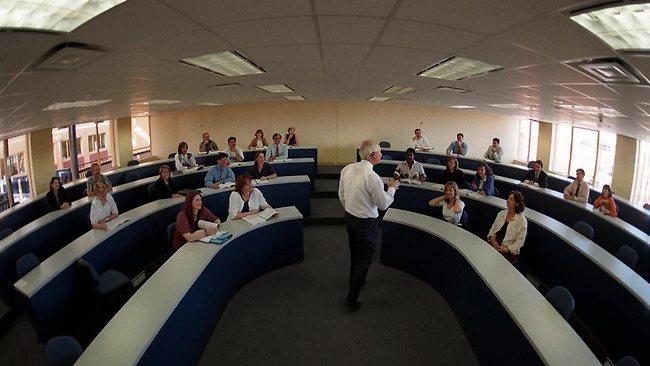Unis lower hurdles to keep numbers
UNIVERSITIES are having to continue to lower entry scores to maintain expanding numbers.

UNIVERSITIES are having to continue to lower entry scores to maintain expanding numbers, sparking warnings that school inequality is to blame as regional and poor students get left behind.
Commonwealth student applications and offer data for this year also show that universities are continuing to recruit into teaching degrees a rising proportion of school leavers with Australian Tertiary Admission Ranks of 50 or less.
This is despite a national debate and state-government moves to try to raise the entry and exit standards of would be teachers.
The proportion of university offers to school leavers with ATARs of 50 or below has doubled over the last two years to 4.1 per cent in 2013, and now 1-in-3 applicants with a score of 50 or below gets an offer of a place, compared with less than 1-in-5 in 2011.
"Expanding higher education is going to require improved school achievements for those students who are unprepared and that means regional students and students from low socio-economic pockets of metropolitan areas," warned La Trobe University student access expert Andrew Harvey.
He said it underscored the need for school reforms to boost quality in disadvantaged schools such as the Gonksi recommendations.
But he said the government was at cross purposes in cutting university funding to pay for its school reforms. "The university sector relies on schools and schools rely on universities," Dr Harvey said.
The commonwealth data shows that university applications from regional/rural students fell by 1.1 per cent compared with a 1.5 per cent rise from metropolitan students. The number of applications from students from among the population's bottom 25 per cent on the economic status scale rose by 1.3 per cent, beating a 0.5 per cent rise in overall applications, but they are still well under-represented.
They accounted for just 18.7 per cent of total applications, while the wealthiest 25 per cent of the population were over-represented, accounting for over 30 per cent of applications.
The proportion of school leavers offered a place in an undergraduate teaching degree who had an ATAR of 50 or less rose to 7.3 per cent this year from 6.5 per cent last year, a proportion higher than any other field. Almost a quarter of offers of a teaching place this year went to students with ATARs of 60 or less.
The NSW government from 2015 will limit school leaver entry into teaching degrees to those scoring at least 80 per cent in the Higher School Certificate in a least three subjects. That is equivalent to an ATAR of over 70.
At the same time the Gillard government wants teaching students to pass literacy and numeracy tests that ensure they are in the top 30 per cent of the population by the time they graduate.
Federal Education Minister Peter Garrett said "using ATAR scores alone is not enough to tell us who will make a great teacher".
He noted that only 27 per cent of entrants into teaching degrees were admitted based on ATARs with others being graduates or mature students.
Australian Education Union federal president Angelo Gavrielatos backs moves to raise standards and said the downward trend in ATARs underscored the union's call for the government to cap the number of places in undergraduate teaching degrees.
Under the commonwealth's demand driven system universities are free to offer as many undergraduate places as they want.
Grattan Institute higher education expert Andrew Norton said the proportion of university places going to students with low ATARs still remained low overall, and would only be a problem if evidence emerged that large numbers are failing or dropping out mid-way through their degrees.
"I'm not convinced it is a large problem yet," he said.


